Unsaturated fats are a broad category of fatty acids we consume in our diets. Although they are commonly known as “healthy fats,” some unsaturated fats can actually worsen our health.
In fact, unsaturated fatty acids represent each end of the health spectrum, from completely toxic trans fats to polyunsaturated and monounsaturated fats that help support optimal health and longevity.
To better understand this complicated category of fats, let’s take a look at unsaturated fatty acids from the following perspectives:
- What is unsaturated fat? The dietary definition
- What is unsaturated fat? From a biochemical perspective
- Unsaturated fatty acid examples
- Saturated vs. unsaturated fat: what is the difference?
- Health benefits of unsaturated fatty acids
- Unsaturated fat food list
- Healthy unsaturated fat recipes
- How much unsaturated fat should we eat?
- The potential harms of unsaturated fatty acids
- Practical takeaways
What is Unsaturated Fat? The Dietary Definition
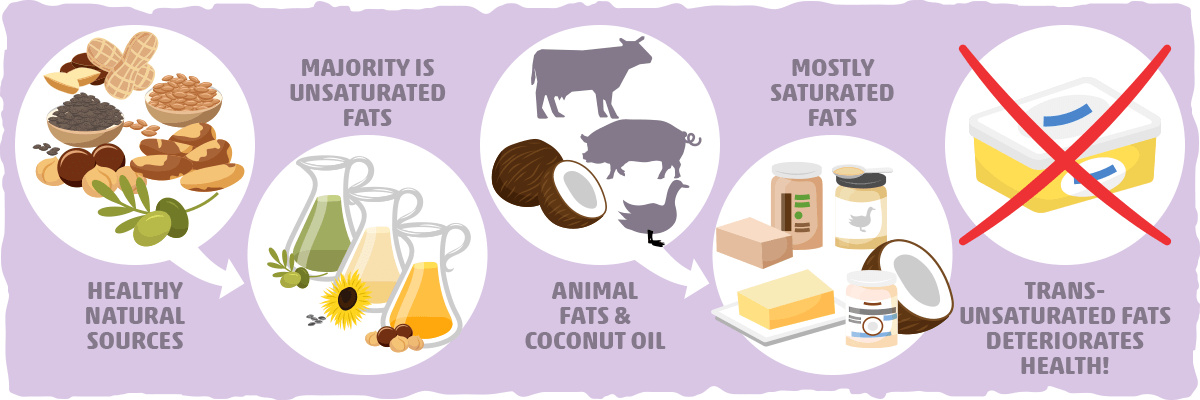
Vegetables, legumes, nuts, seeds, and the oils derived from these foods mostly consist of unsaturated fats. In general, if a cooking oil is liquid at room temperature, the majority of its fat content will be unsaturated.
In contrast, animal fats and coconut oil tend to be solid at room temperature because they are mostly made up of saturated fats.
This simple difference in physical properties also reflects the varying impacts each type of fat can have on our health. Unsaturated fats are typically regarded as healthy fats because they improve various biomarkers of health more effectively than saturated fat, which tends to improve certain biomarkers (e.g., by raising HDL cholesterol levels) and may worsen others (e.g., by increasing LDL cholesterol levels).
Most unsaturated fats follow this general pattern. Once they are processed into trans unsaturated fats, however, we end up with a completely different story.
Artificial trans fats, for example, are processed in such a way that it makes polyunsaturated fats solid at room temperature and lengthens their shelf life.
This rapid shift in physical properties is indicative of how it changes the health effect of the fat – completely transforming what was once a healthy fat into a type of trans-unsaturated fat that rapidly deteriorates our cardiovascular health.
To develop a better understanding of why unsaturated fats are like this, we must take a look at them through a microscope.
What is Unsaturated Fat? From a Biochemical Perspective
The technical definition of unsaturated fat is a fatty acid in which there is at least one double bond in the carbon chain. However, since most of the fat we consume consists of long-chain fats with 14 or more carbons, this simple classification leaves a lot to the imagination.
Take a look these unsaturated fatty acids for example:
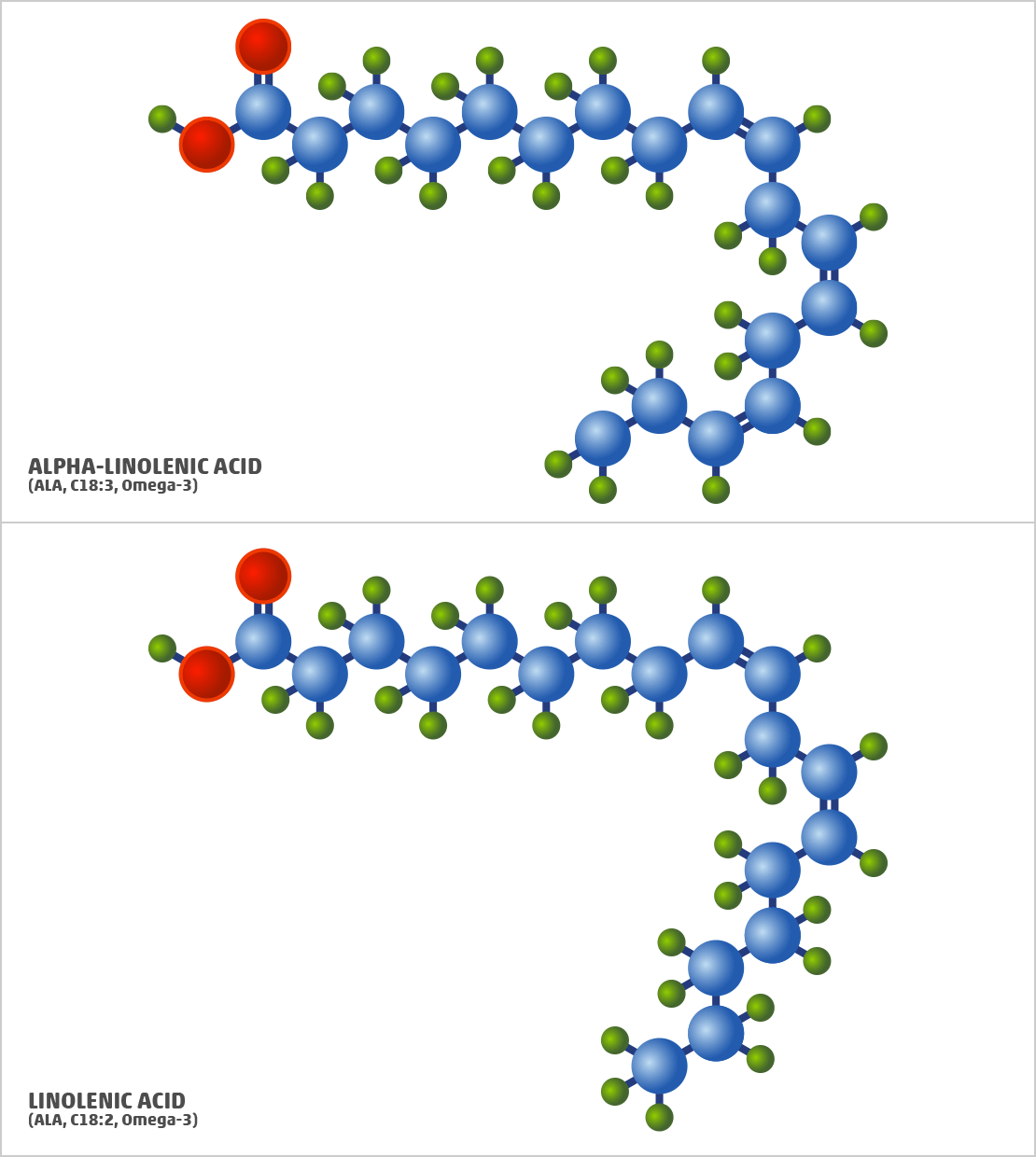
Each one is an essential fatty acid that we must get from our diets for optimal health. An extra double bond here, a modified double bond location there, and we are left with two entirely different fatty acids that are used by our bodies in entirely different ways.
This example helps us highlight the potential for endless iterations of unsaturated fatty acids. This is why it is helpful to break them down into two categories:
- Monounsaturated fats (MUFAs)
- Polyunsaturated fats (PUFAs)
A fatty acid is monounsaturated if it contains one double bond, and polyunsaturated if it contains more than one double bond.
This simple difference in chemical structure leads to a significant change in how our body metabolizes it and how it affects our health.
Another variation worth noting is the double bond type. PUFAs and MUFAs contain exclusively cis-double bonds. The “cis” tells us that the hydrogen atoms that are attached to the double-bonded carbon atoms are found on the same side of the fatty acid chain.
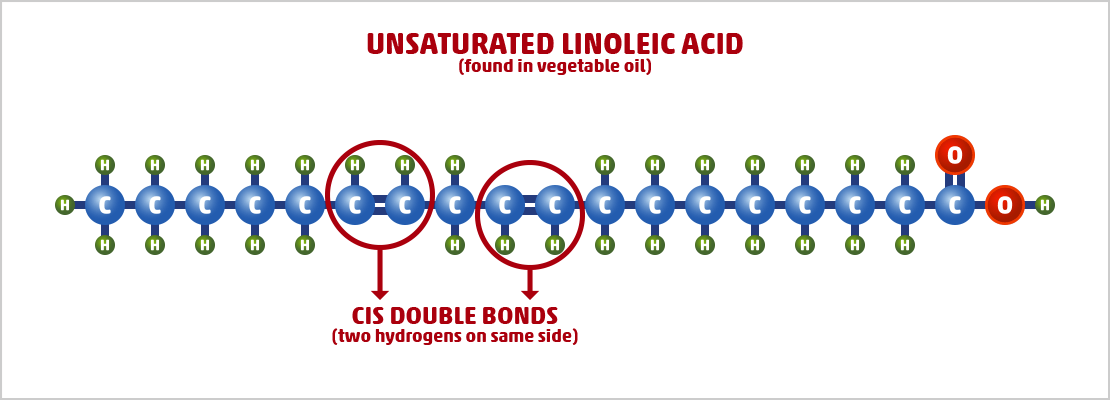
After these cis-unsaturated fatty acids are processed – artificially via partial hydrogenation or naturally in a ruminant’s stomach – they can become trans-unsaturated fatty acids (commonly known as trans fats). The “trans” indicates that the hydrogen atoms attached to the double-bonded carbon are now on the opposite side of the fatty acid chain.
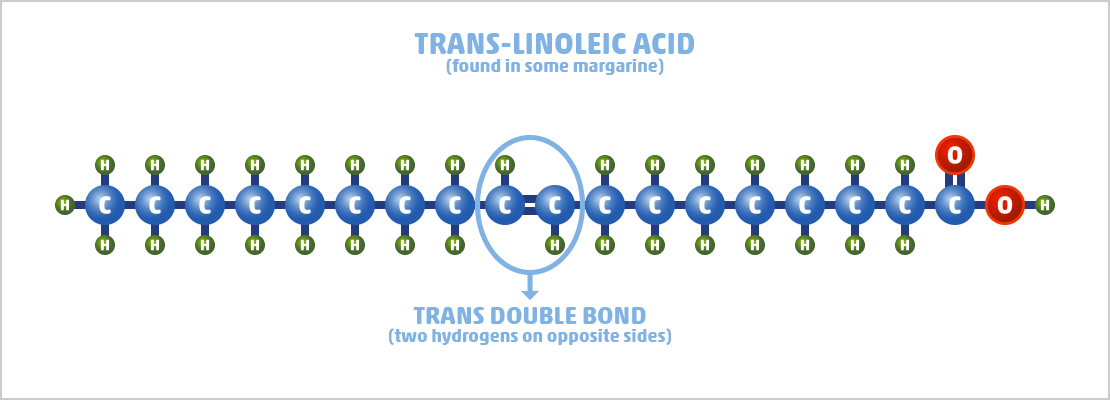
Natural and artificial processing lead to distinct differences in how many cis-bonds they change. This translates to contrasting health effects between natural trans fats and artificial trans fats as well.
Long story short, unsaturated fat is a fatty acid with at least one carbon-carbon double bond in its carbon chain. The number, location, and type of these double bonds all vary in specific ways that are encapsulated in the four main types of unsaturated fatty acids:
- Monounsaturated fats – a fatty acid that contains only one carbon-carbon double bond
- Polyunsaturated fats – a fatty acid that includes more than one carbon-carbon double bond
- Natural trans-unsaturated fats – a fatty acid with at least one trans-double bond and one cis-double bond that is formed naturally in a ruminant’s stomach.
- Artificial trans-unsaturated fats – a fatty acid with no cis-double bonds and at least one trans-double bond that is formed artificially through a process called hydrogenation.
Let’s take a look at some examples of each unsaturated fat to add some color to these fundamental concepts.
Unsaturated Fatty Acid Types with Examples
The four types of unsaturated fat contain a plethora of different fatty acids that vary in length, double bond location, double bond amount, and/or double bond types. Below you’ll find examples of each type of unsaturated fat and common foods they are found in.
Monounsaturated Fat Examples
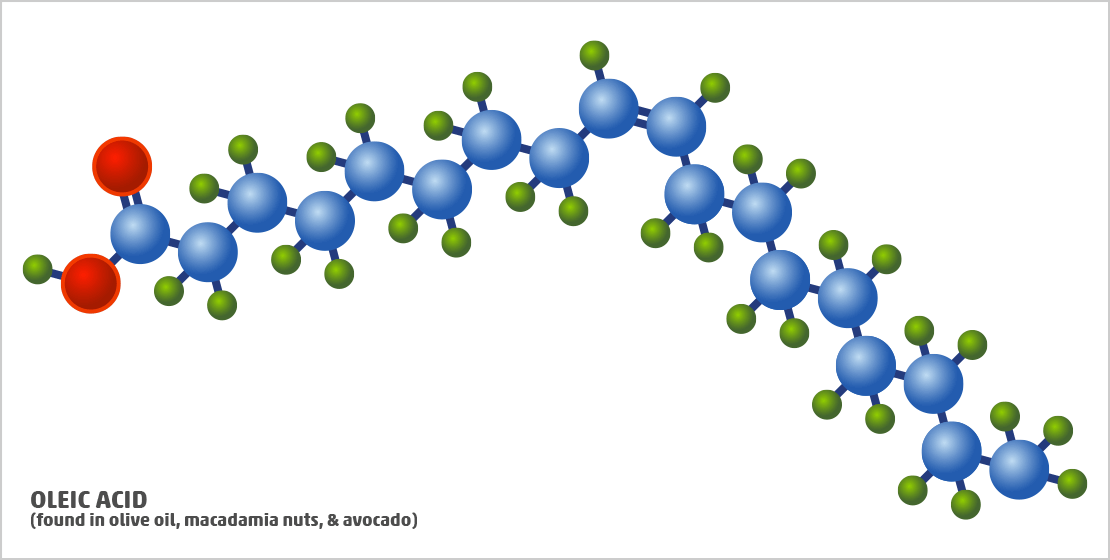
The most common monounsaturated fat you’ll consume is oleic acid. In fact, it is the most widely distributed and abundant fatty acid in nature.
Olive oil, macadamia nuts, and avocado are the best sources of this monounsaturated fatty acid, which is responsible for many of the health benefits these foods can provide us.
Polyunsaturated Fat Examples
Polyunsaturated fats are consumed as either omega-6 or omega-3 fatty acids, which differ in where their first double bond is found from the end of the carbon chain (i.e., from the methyl group).
Linoleic acid (an omega-6 fatty acid) and α-linolenic acid (an omega-3 fatty acid) are two commonly consumed PUFAs. They are also known as essential fatty acids because we cannot synthesize them.
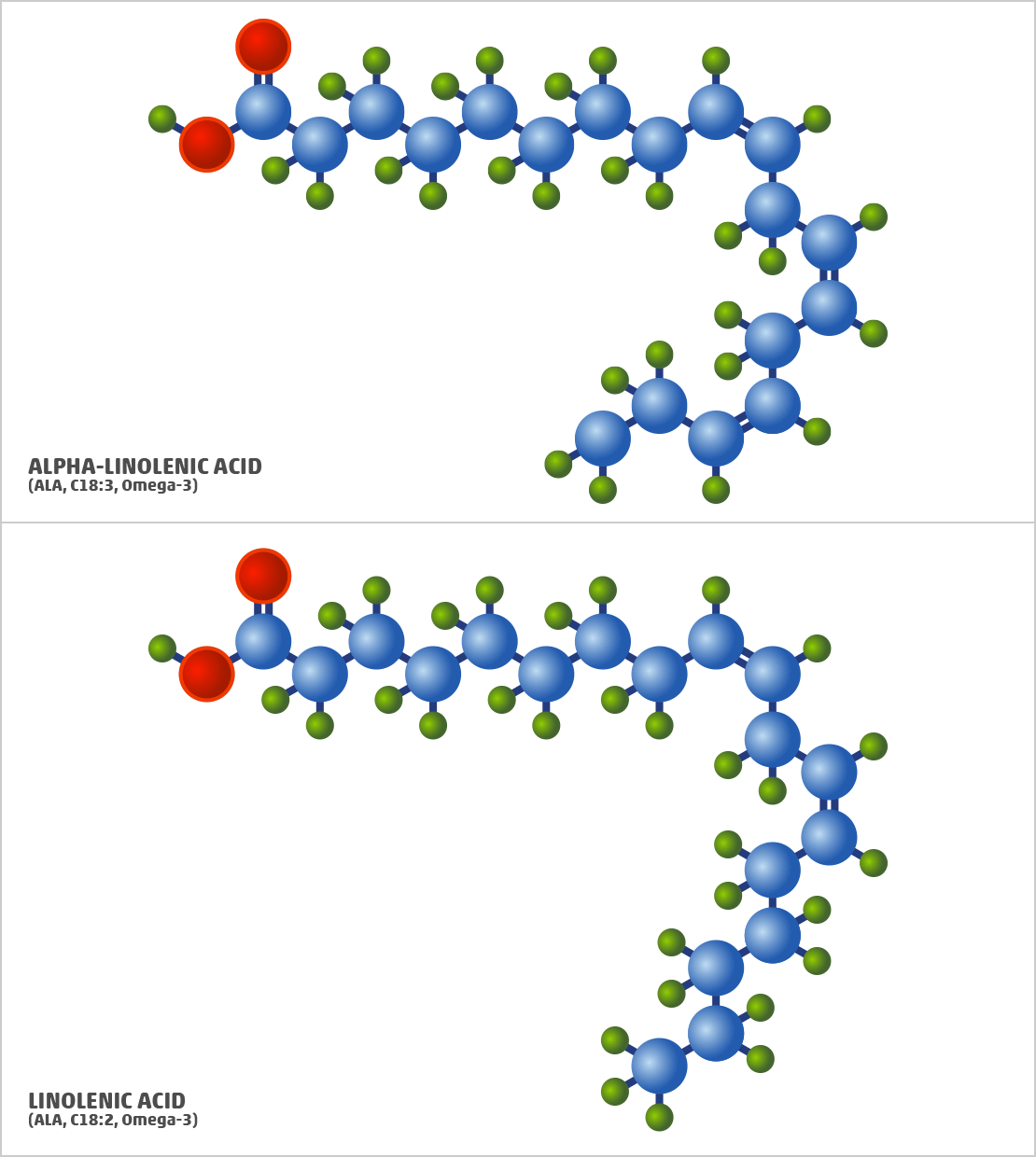
You will find polyunsaturated fats in all plant and animal foods. Linoleic acid is found in higher quantities in nuts, seeds, and vegetable oils, while the best sources of α-linolenic acid are flaxseeds, chia seeds, walnuts, and hemp seeds.
Natural Trans-unsaturated Fat Examples
Natural trans fats are also known as conjugated linoleic acids (CLA). CLA represents a group of trans fats that are naturally formed during the process of linoleic acid digestion in ruminants.
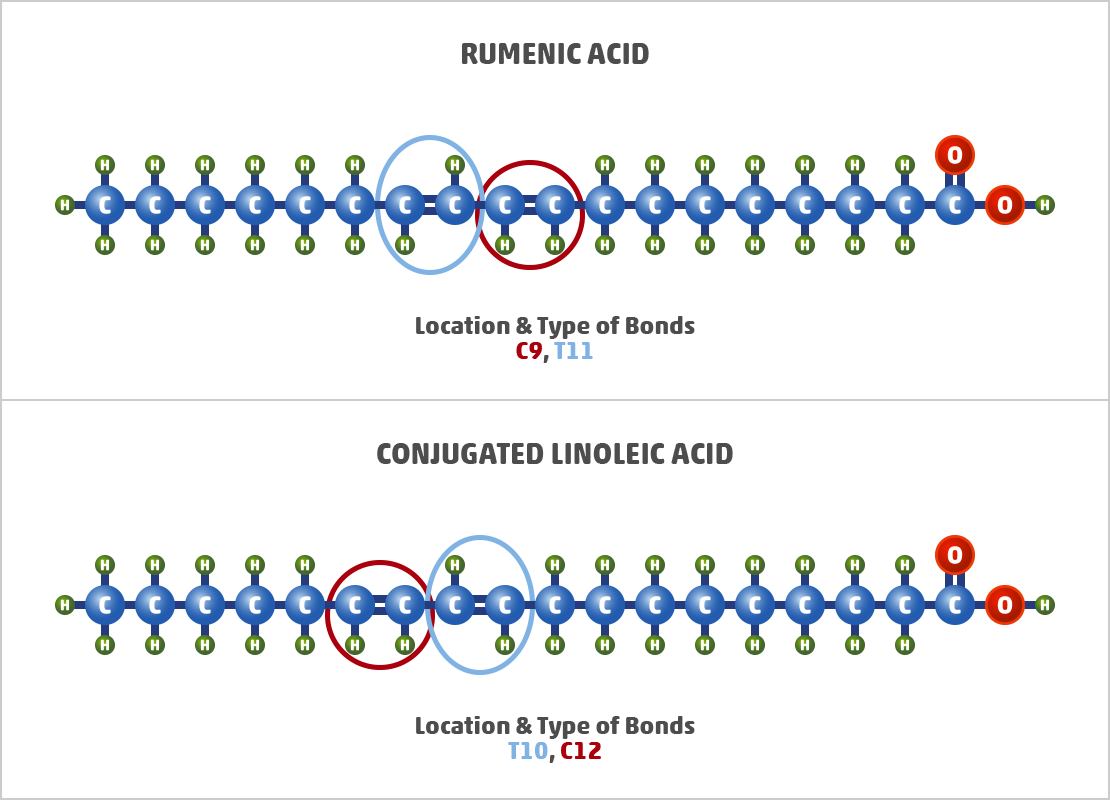
As you can see, these fats have both trans and cis double bonds in their carbon chains. This is why we refer to these fatty acids as being “conjugated.”
These trans fats typically make up 2-5% of the fat in dairy products and 3-9% of the fat in beef and lamb. One of the most common types of CLA found in these foods is known as rumenic acid (the c9, t11 CLA pictured above).
Research indicates that CLA may have some benefits. The same cannot be said for artificially-produced trans fats.
Artificial Trans-unsaturated Fat Examples
Although natural and artificial trans fats both fall under the same “trans fat” category, they have different chemical structures and vastly different effects on our health.
Artificial trans fats are developed via a process called hydrogenation. This leads to the creation of non-conjugated trans-linoleic acid (i.e., it no longer has a cis-double bond).
Here’s an example of what happens when we partially hydrogenate vegetable oils:
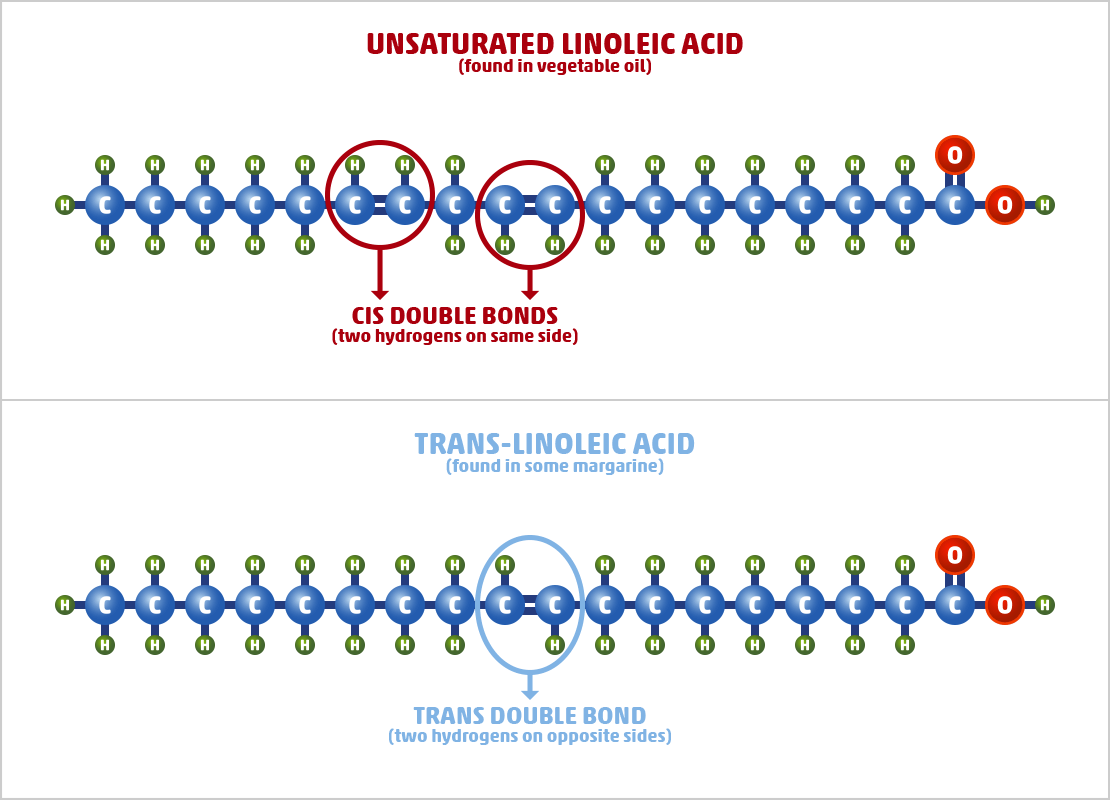
What was previously an essential omega-6 fatty acid with multiple cis-double bonds (i.e., linoleic acid) will lose its cis-double bonds and gain a trans-double bond. In other words, the artificial process of hydrogenation transforms what was once a healthy fat into a toxic version of trans fat.
You’ll find these harmful fats in margarine and any product that contains a partially hydrogenated oil (even if the label says it has 0 grams of trans fat).
Saturated vs. Unsaturated Fat: What is the Difference?
Although unsaturated fatty acids make up a large portion of the fat in our diets, we cannot forget about saturated fat. Knowing the difference between the two is crucial to our understanding of healthy fat intake.
Deciphering between saturated fat and unsaturated fat is relatively simple. Unsaturated fats have at least one carbon-carbon double bond while saturated fats have only carbon-carbon single bonds.
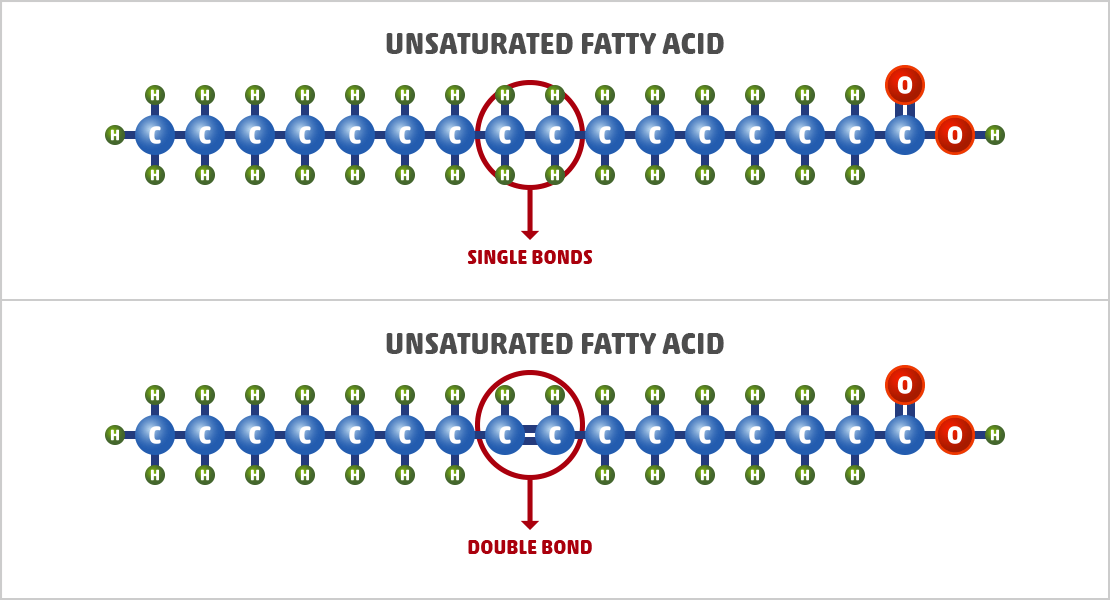
Put in another way, saturated fats are “saturated” with hydrogen atoms, while unsaturated fats do not have the maximum amount of hydrogen atoms a fatty acid can have, making them “unsaturated.”
Another way of remembering the difference is that saturated fats are “saturated” in single carbon-to-carbon bonds. Unsaturated fats, on the other hand, have at least one carbon-carbon double bond.
Both types of fats are found throughout the plant and animal kingdom. Plant oils, however, tend to contain mostly unsaturated fats while animal fats usually consist of a higher quantity of saturated fatty acids.
Butter, lard, and tallow, for example, are mostly made of saturated fatty acids. In contrast, common plant oils like olive oil, canola oil, and avocado oil are predominantly unsaturated.
This difference in fatty acid content is the main reason why animal fats are solid at room temperature and why most plant-based oils are liquid at room temperature. These variations also play a significant part in how these foods affect our health.
The deciphering factor responsible for many of these differences is whether or not the fatty acid is saturated or unsaturated.
Monounsaturated fats and polyunsaturated fat, for example, are widely accepted as being healthy fats because the data consistently shows they can significantly improve several important health biomarkers when consumed in place of calories from saturated fat and artificial trans fat in the diet. Let’s take a closer look at some of these findings in the next section.
Health Benefits of Unsaturated Fatty Acids
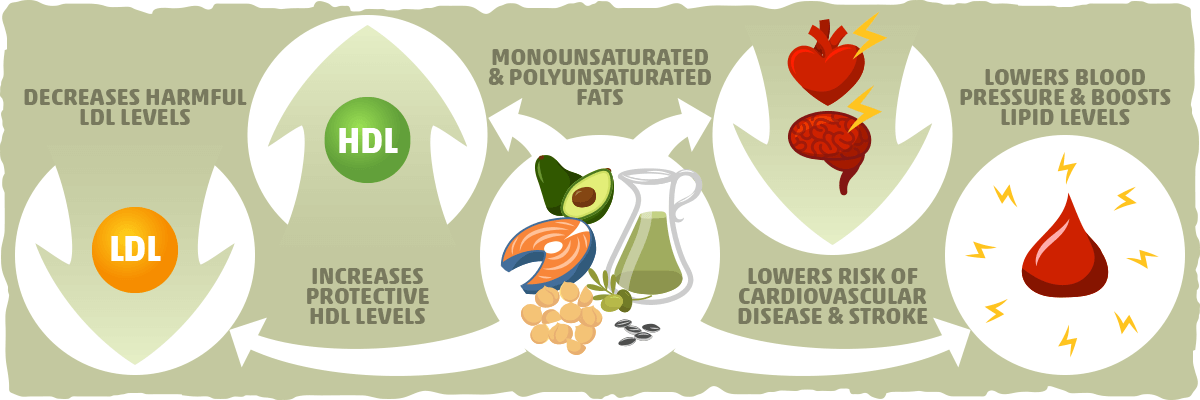
In general, most of the research on unsaturated fats explores the effects of polyunsaturated fats and monounsaturated fats on several common heart disease risk factors. This is especially important because cardiovascular disease is the number one cause of death worldwide, and it is possible to prevent many of these deaths with dietary intervention.
The current research literature overwhelmingly suggests that consuming polyunsaturated fats and monounsaturated fats instead of trans fats and saturated fats will lower the risk of cardiovascular disease and stroke.
A meta-analysis of 60 trials also indicates that these fats serve as a healthy replacement for some carb intake as well. More specifically, they found that when polyunsaturated and monounsaturated fats were eaten in place of carbohydrates, these healthy fats decreased levels of potentially harmful LDL and increased protective HDL levels.
More recently, the Optimal Macronutrient Intake Trial for Heart Health (OmniHeart) showed that replacing a carbohydrate-rich diet with one high in unsaturated fat (predominantly monounsaturated fats) lowers blood pressure, improves lipid levels, and reduces cardiovascular risk.
In short, replacing some of our carb, artificial trans fat, and/or saturated fat intake with polyunsaturated fats and monounsaturated fats can help promote heart health and reduce the risk of heart disease. This is the primary reason why these fats are typically called “healthy fats” or “good fats.”
However, this isn’t all these fatty acids have to offer. They have many unique benefits as well.
The Unique Benefits of Polyunsaturated Fats
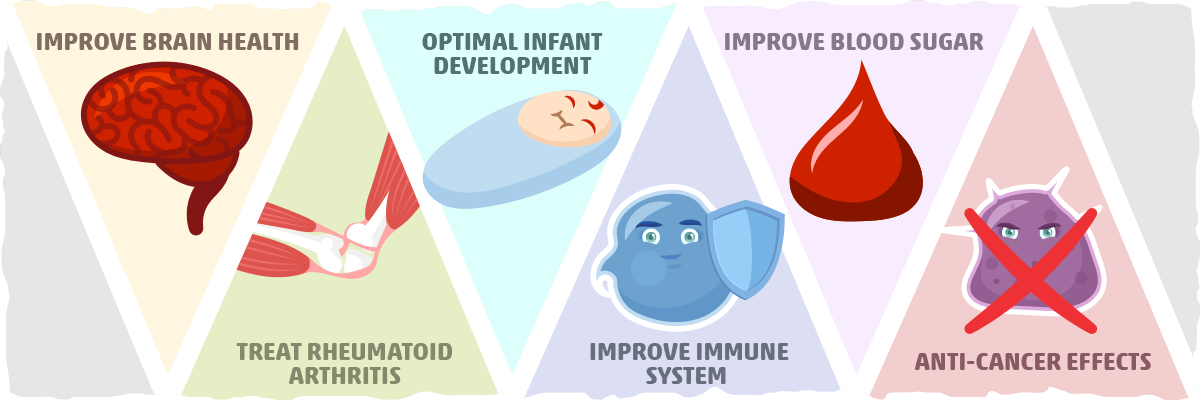
Let’s take a quick look at some of the noteworthy benefits specifically associated with omega-3s and/or omega 6s (the two types of PUFAs):
- Omega-3s may improve overall brain health. Some studies indicate that specific populations can use DHA+EPA (two long-chain omega 3s) to enhance cognitive function.
- Omega-3s can help treat rheumatoid arthritis. EPA + DHA can reduce inflammation, which has been found to be helpful for some patients suffering from rheumatoid arthritis.
- Omega-3s and omega-6s ensure optimal infant development. Sufficient consumption of DHA + EPA and omega-6s during pregnancy can improve infant development and reduce the likelihood of adverse developmental outcomes.
- Omega-6 and omega-3s can help improve immune system function. The two types of PUFAs help regulate inflammation, allowing us to respond to potential threats and tissue damage appropriately. Consuming an adequate amount of omega-3s and omega-6s will help ensure that our immune system isn’t hyperactive or underactive.
- Polyunsaturated fats reduce type 2 diabetes risk and improve blood sugar regulation. A recent meta-analysis of randomized controlled feeding trials found that, In comparison to carbohydrates, saturated fats, and monounsaturated fats, PUFAs exert the most consistent favorable effects on metrics associated with improved blood sugar levels, insulin resistance, and insulin secretion capacity.
- Omega-3s may have anti-cancer effects. Some research indicates that omega-3s modulate gene expression in a way that can impair the proliferation of certain cancers.
For an in-depth breakdown of the research behind these findings, check out our article on polyunsaturated fatty acids and their benefits.
The Unique Benefits of Monounsaturated Fats
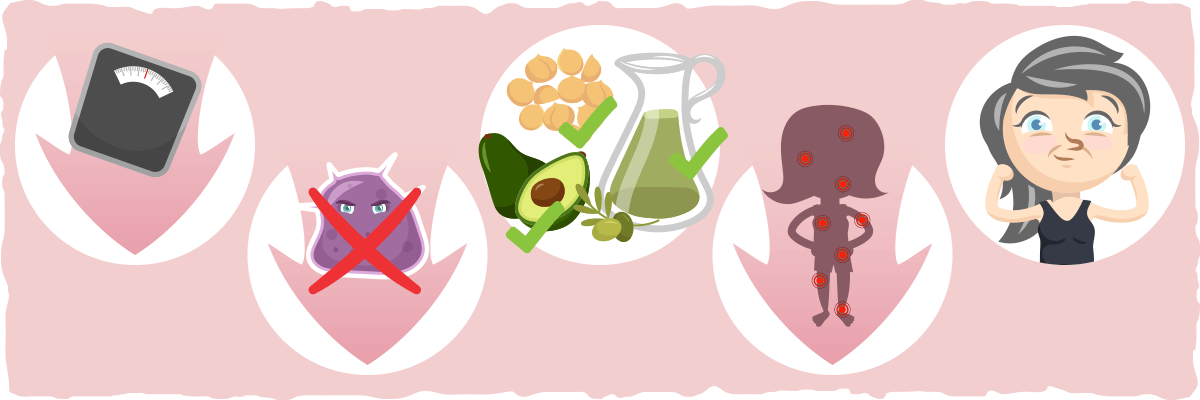
Let’s take a quick look at some of the unique benefits specifically associated with MUFAs:
- Increased weight loss. Some evidence suggests that monounsaturated fats can promote more fat burning and yield more weight loss when compared to the consumption of saturated fat.
- May reduce the risk of several cancers. MUFA consumption is associated with a reduced risk of colon, breast, and prostate cancers. However, more research is needed to confirm these correlations and investigate potential mechanisms.
- Reduced inflammation. When compared to other diets, including high-saturated-fat diets and Western diets, high-MUFA diets have been found to reduce inflammation. One study, for example, found that high-MUFA diets decreased inflammation in patients with metabolic syndrome when compared to those following high-saturated-fat diets.
- Increased longevity. One large observational study discovered that replacing 5% of energy from saturated fats with the equivalent amount of energy from MUFAs was associated with an estimated 13% reduction in total mortality.
For an in-depth breakdown of the research behind these findings, check out our article on monounsaturated fatty acids and their benefits.
The Potential Benefits of Natural Trans Fats (CLA)
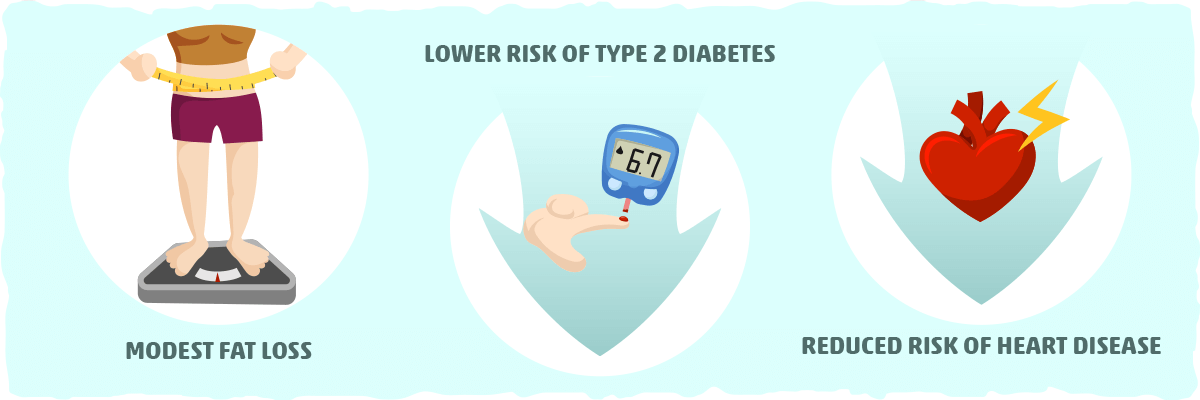
The effects of conjugated linoleic acids (CLA) are rarely a part of the unsaturated fatty acid conversation, but there are two potential benefits worth noting:
- Increased fat loss. A meta-analysis of CLA studies found that a 2 g/d dose produces modest body fat loss. When compared with placebo, this translated to roughly 0.2 lbs of fat loss per week.
- May reduce the risk of several diseases. Observational studies indicate that individuals who have more CLA in their fat may have a lower risk of type 2 diabetes, cardiovascular disease, and certain types of cancer.
As a whole, however, the research on CLA is convoluted and inconclusive. Each type of CLA seems to have varying effects on health as do different mixtures of CLAs.
High dose supplementation with CLA also seems to cause more harm than good, so it is best to consume CLA from the natural sources you’ll find in the following section.
Unsaturated Fat Food List
We have plenty of options to increase our consumption of healthy unsaturated fats. Nuts, seeds, meat, fish, refined food products, and processed oils all can be used to get more MUFAs, PUFAs, and CLA, but not all of them will promote health and vitality.
The research suggests that the healthiest sources of these fats are minimally-processed whole foods and stable cooking fats/oils. Many of these options are also keto-friendly, which makes them excellent replacements for higher carb foods as well.
Here is a graphical list of some healthy low-carb foods that are high in unsaturated fats. To see a more detailed, broken down section feel free to scroll below the graphic:
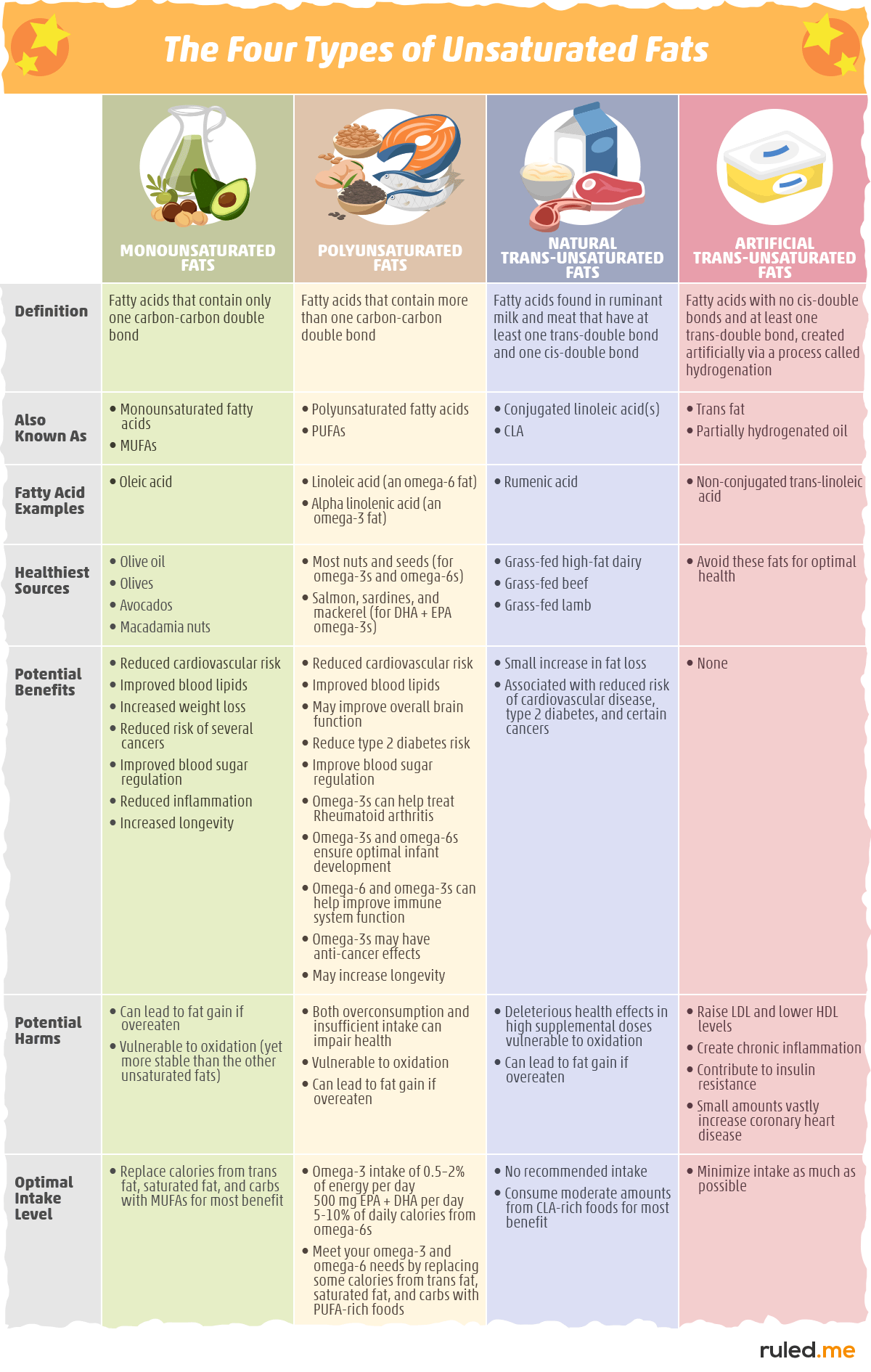
Foods high in unsaturated fats:
- Avocados. Chock-full of monounsaturated fats, fiber, and micronutrients, avocados can be a versatile staple of any healthy diet.
- Nuts, seeds, and peanuts. These fatty morsels are mostly made up of unsaturated fatty acids. Some serve a great source of monounsaturated fat, while others are known for their high PUFA content. We will take a closer look at the specifics in the next two subsections.
- Olives. These small fruits derive more of their calories from fat than any other commonly consumed fruit. They also are filled with the health-promoting MUFA oleic acid.
- Fatty fish. It crucial to meet our omega-3 PUFA needs for optimal health, and eating fatty fish is the most efficient way to do so. Salmon, mackerel, and sardines are some examples of fatty fish that are both high in DHA+EPA and safe to consume on a weekly basis.
- Duck, chicken, pork, and goose fat. Animal fats contain mostly monounsaturated fats and saturated fats with some polyunsaturated fatty acids mixed in. Duck, chicken, pork, and goose fats all contain more monounsaturated fat than any other type of fat, making them a great source of healthy unsaturated fats.
- Beef, lamb, and dairy products. These foods represent widely-available natural sources of CLA (natural trans fats) in our diet. However, they are relatively low in other unsaturated fats. Opt for pastured-raised, grass-fed products for the most CLA-rich and the healthiest meat and dairy.
Keep in mind, however, that all plants and animals contain varying amounts of polyunsaturated and monounsaturated fats. The above list represents those that are particularly high in one, the other, or both.
You can also benefit from these fats when adding certain fats/oils to your diet. Here is a list of some unsaturated fat-rich oils/fats with their recommended use for optimal health:
- Olive oil. Olive oil is packed with MUFAs and polyphenols that have been proven to improve health. According to recent research, extra virgin olive oil is best for high-heat cooking.
- Avocado oil. An excellent source of monounsaturated fats that is relatively stable at medium-high heat.
- High oleic sunflower/safflower oil. Both are made from seeds that are naturally selected for high-MUFA content. These oils are also the best dietary source of oleic acid and are likely to be as stable as avocado oil.
- Macadamia nut oil. Another great source of monounsaturated fat. Best if used to add some extra flavor and fat on top of meals, but not as cooking oil.
- Other vegetable, nut, and seed oils. Most of the oils derived from vegetables, nuts, and seeds are high in polyunsaturated fats. These fats oxidize easily during processing, cooking, baking, and frying, so it is best to use these sparingly. Some popular examples of these oils are canola oil, peanut oil, soybean oil, and vegetable oil.
- Duck, chicken, pork, and goose fat. Since these fats are higher in saturated fat, they tend to be more stable when exposed to heat. They can also be used to add a uniquely satisfying flavor to your favorite dishes.
For those of you looking to add more of a particular unsaturated fat to your diet, take a look at the lists below.
Monounsaturated Fat Foods, Fats, and Oils
The healthiest low-carb and keto-friendly foods with the highest percentage of MUFAs are as follows (with more than 50% of their fat coming from MUFAs):
- Macadamia nuts and homemade macadamia nut butter
- Olives
- Hazelnuts and sugar-free hazelnut butter
- Avocados
- Almonds and sugar-free almond butter
- Pecans and sugar-free pecan butter
- Peanuts and sugar-free peanut butter
Some examples of zero-carb fats/oils rich in monounsaturated fats (with >50% of fat coming from MUFAs) are:
- High-oleic safflower and sunflower oils (best source of oleic acid)
- Extra virgin olive oil (best for high-heat cooking)
- Avocado oil
- Macadamia nut oil
- Goose fat
Here are some examples of animal fats that are highest in these fats (~40-50% of fat coming from MUFAs):
- Goose fat
- Herring
- Duck fat
- Chicken fat
- Lard and other high-fat pork products like bacon
Polyunsaturated Fat Foods and Oils
To ensure optimal PUFA intake, it is best to consume a sufficient amount of omega-3s and omega-6s. This is why our polyunsaturated food list consists of two subcategories.
Best Sources of Omega-3 PUFAs
Arguably the healthiest way to meet your omega-3 needs is by consuming low-mercury fatty fish.
Here is a list of keto-friendly foods that contain the most DHA and EPA:
- Salmon
- Sardines
- Mackerel
- Rainbow Trout
- Sea Bass
And a list of the best sources of Alpha-linolenic acid (ALA):
- Chia seeds
- Walnuts
- Flaxseeds
However, make sure you are not relying on ALA intake from plants to meet your EPA and DHA needs. Most of the benefits of omega-3s come from consuming EPA and DHA directly.
Best Sources of Omega-6 PUFAs
Here is a list of some keto-friendly foods with high omega-6 content:
- Walnuts
- Sunflower seeds
- Pine nuts
- Mayonnaise (with soybean oil)
- Bacon
- Peanuts
- Almonds
- Chicken thighs (with skin)
- Eggs
- Butter
Natural Trans-fat Foods: Sources of CLA
CLAs are not ubiquitous in nature like MUFAs and PUFAs. Since they rely on the fermentation of certain fatty acids in ruminant stomachs, we must look for specific animal products to get some CLA.
Here’s a list of the most widely available CLA sources:
- High-fat dairy products (e.g., butter, heavy cream, and cheese)
- Fatty cuts of beef
- Fatty cuts of lamb
Pasture-raised, grass-fed animals tend to have more CLA in their dairy products and meat. Animals raised in this way are also healthier for us and the environment, so we recommend opting for pastured-raised, grass-fed beef, lamb, and dairy instead of buying the conventionally-raised, grain-fed varieties.
Healthy Unsaturated Fat Recipes
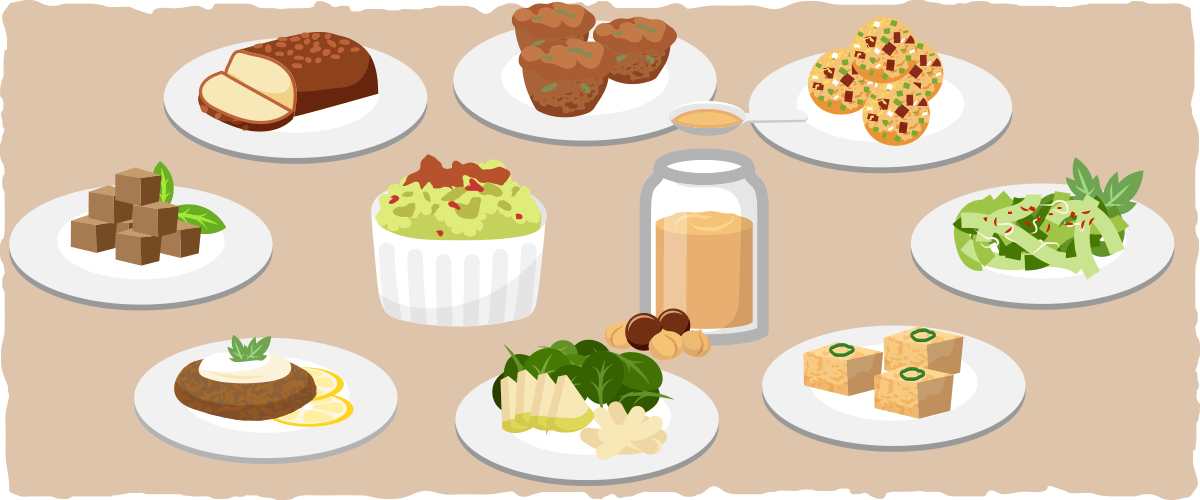
Each one of these recipes is keto-friendly and rich in both PUFAs and MUFAs. If you need help with increasing your intake of certain types, use the food list from above to guide your recipe choices. Feel free to check out our in-depth articles on polyunsaturated fats and monounsaturated fats for more specific recipes a well.
Low Carb Breakfast Recipes High in Unsaturated Fat:
- Keto Zucchini Bread with Walnuts
- Bacon Avocado Muffins
- Salmon Benny Breakfast Bombs
- Maple Pecan Fat Bomb Bars
Low Carb Lunch Recipes High in Unsaturated Fat:
- Bacon and Roasted Garlic Guacamole (with pork rinds)
- Five Minute Marinated Feta & Sun-dried Tomato Salad
- Sesame Salmon Salad
- Salmon Lettuce Cups with Lemony Basil Spread
Low Carb Snack Recipes High in Unsaturated Fat:
- Homemade Macadamia Nut Butter
- Pecan Butter Chia Seed Blondies
- Smoked Salmon and Goat Cheese Bites
- Almond Butter Chia Squares
Low Carb Dinner Recipes High in Unsaturated Fat:
- Zucchini Ribbons & Avocado Walnut Pesto
- Sesame Almond Zoodle Bowl
- Creamy Lemon and Dill Pan Seared Salmon
- Cajun Salmon Cakes
Low Carb Sides that are High in Unsaturated Fat:
- Spinach Watercress Keto Salad
- Jalapeno Cornbread Mini Loaves
- Keto Mushroom Wild Rice Pilaf
- Raspberry Pecan Salad
Low Carb Dessert Recipes High in Unsaturated Fat:
- Speculoos and Macadamia Biscotti
- Keto Chocolate Peanut Butter Tarts
- Mini Pumpkin Spice Muffins
- Chocolate Chunk Avocado Ice Cream
How Much Unsaturated Fat Should You Eat for Optimal Health?
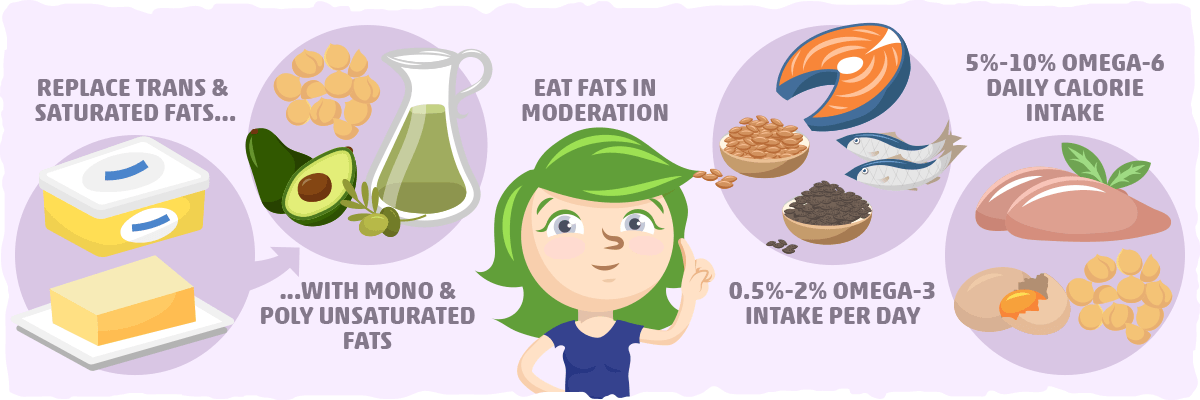
There is no universally optimal intake level of polyunsaturated fat, monounsaturated fat, or CLA. The only unsaturated fat that has any specific quantity attached to it is artificial trans fat – and that optimal intake level is zero grams.
The general recommendation is to replace all artificial trans fats and some saturated fats with polyunsaturated fats and monounsaturated fats. Research also suggests that substituting healthy fats for high-carb foods is a great way to improve health as well.
That being said, there is an intake limit to these fats for optimal health. Consuming most of your fat from omega-3s and omega-6s, for example, may not be prudent, given the potential for oxidation and the lack of research supporting excessive PUFA intake.
When it comes to polyunsaturated fat intake, getting the right amount of omega-6s and omega-3s is crucial.
The World Health Organization recommends an omega-3 fatty acid intake of 0.5–2% of energy per day. The American Heart Association specifically recommends that we get at least two servings of fatty fish per week or 500 mg EPA + DHA per day.
Regarding omega-6 intake, a recent analysis conducted by the American Heart Association emphasizes the importance of consuming at least 5-10% of daily calories from omega-6 fatty acids.
Altogether, these recommended intakes represent the estimated amount of omega-6 and omega-3 we need for optimal health. The healthiest way to meet these needs is by replacing heavily processed foods and oils with the nutrient-rich foods and recipes that we learned about previously.
In contrast to PUFAs, you can only go wrong with MUFA consumption if you eat so much of them that it leads to fat gain. As long as you are eating the right amount of calories to reach your goals and meeting your other nutritional needs with healthy foods, feel free get as many of those calories from MUFA-rich foods, fats, and oils as you’d like.
CLA intake follows similar logic but should not be prioritized over PUFA and MUFA consumption. Grass-fed high-fat dairy, beef, lamb, and meat from other ruminants should serve as the only sources CLA because they don’t come with the health risks of higher supplemental doses and provide us with other beneficial nutrients.
The Potential Harms of Unsaturated Fatty Acids
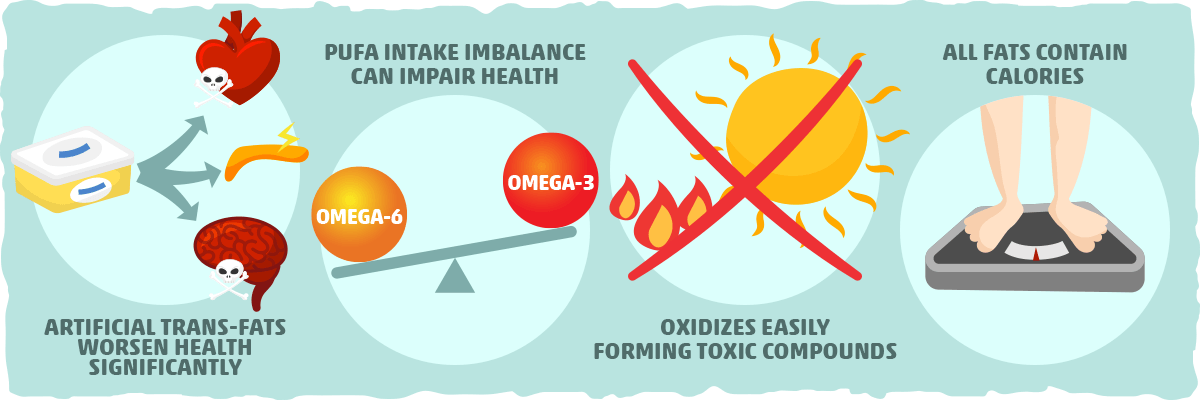
Although unsaturated fats can confer unique and significant health benefits when compared to saturated fat and carbs, they do have a dark side. We hinted at the four harms of these fats throughout this article, but it is crucial that we state them explicitly. We will start with the most obvious:
Artificial Trans Fats Worsen Health Significantly
Artificial trans fats are – without a doubt – the worst type of fat for overall health because they:
- Raise LDL and lower HDL levels.
- Create chronic inflammation, which is associated with heart disease, stroke, diabetes, and other chronic conditions.
- Contribute to insulin resistance and type 2 diabetes.
- Even small amounts have a substantial impact on our health. One meta-analysis found that, for every 2 percent increase of calories consumed from trans fat daily, the risk of coronary heart disease increases by 23%.
In other words, these fats can potentially reverse all of the positive health progress you make by eating healthy fats.
In light of these findings, there are no safe levels of trans fat to consume each day. Keeping our daily intake as low as possible is crucial for optimal health.
To do this, we must avoid products that contain any type of partially hydrogenated oil – even if the label claims it has no trans fat.
Partially hydrogenated oils are commonly found in the following products:
- margarine
- vegetable shortening
- packaged snacks
- premade baked goods
- ready-to-use dough
- fried foods
- coffee creamers, both dairy and nondairy
Imbalanced PUFA Intake Can Impair Health
Health issues typically arise when we are not consuming enough or eating too much of either PUFA. Science shows that it’s crucial to get the proper amount of omega-3 fatty acids and omega-6 fatty acids from nutrient-rich sources such as fatty fish, nuts, seeds, eggs, and fresh meat.
This simple strategy will ensure that you get the benefits you expect from PUFAs. Plus, by consuming nutrient-rich whole foods, you can help mitigate the 3rd potential harm of these fragile fats.
Some Unsaturated Fats can Oxidize Easily and Form Toxic Compounds
Carbon-carbon double bonds increase the instability of the fatty acid. As a result, monounsaturated and polyunsaturated fats both are vulnerable to oxidation when exposed to excess air, light, and heat.
Once these fats oxidize, they form harmful compounds that are toxic to the body and rob us of the health benefits that we expect from these fats.
Polyunsaturated fats are the most vulnerable to oxidation because of their multiple double bonds, while MUFAs are typically able to sustain higher temperatures with less oxidation.
Research also suggests that CLA may be even more vulnerable than certain types of polyunsaturated fatty acids as well.
Because of this, both high-PUFA and CLA-rich foods/fats/oils should be stored in a cool dark place and prepared using low cooking temperatures. This will help minimize the harm and maximize the benefits of these unsaturated fats.
All Fats Contain Calories
Just because they are known as healthy fats doesn’t mean you should consume as much as possible. All fats, including unsaturated fatty acids, contain roughly 9 calories per gram — more than twice the calories found in carbs and protein.
If you’re not careful with your consumption of these fats, you might exceed your calorie needs and gain fat. This is why it is crucial to follow the strategy we laid out earlier – i.e., replace all of your trans fat and some of your saturated fat and carb intake with healthy unsaturated fats.
Putting It All Together — Everything You Need to Know About Unsaturated Fat
There are four types of unsaturated fat found in our diets:
- Polyunsaturated fat (PUFAs) – fatty acids that contain more than one carbon-carbon double bond.
- Monounsaturated fat (MUFAs) – fatty acids that contain only one carbon-carbon double bond.
- Natural trans-unsaturated fatty acids – fatty acids found in ruminant milk and fat that have at least one trans-double bond and one cis-double bond. They are commonly known as conjugated linoleic acids (CLA).
- Artificial trans-unsaturated fatty acids – fatty acids with no cis-double bonds and at least one trans-double bond, created artificially via a process called hydrogenation.
PUFAs and MUFAs are known as the “healthy” fats because they improve health more effectively than any other types of fat. These fats benefit us most when we replace all of our trans fat and some of our saturated fat and carb intake with healthy unsaturated fat foods.
The research on natural trans-unsaturated fatty acid is not as conclusive. They can help increase fat loss by a small amount but may not benefit overall health.
All in all, the research literature suggests that the healthiest approach to fat intake is to consume plenty of minimally processed whole foods and stable cooking fats/oils that are high in PUFAs and/or MUFAs. Many of these options are also keto-friendly, which makes them great replacements for carb-heavy foods.
Some of the best unsaturated fat food choices are as follows:
- Avocados
- Nuts, seeds, and peanuts
- Olives
- Fatty fish such as sardines, salmon, and mackerel
- Duck, chicken, pork, and goose
- Beef, lamb, and high-fat dairy products (for CLA)
You can also benefit from these fats when adding certain fats/oils to your diet. Here is a list of some healthy unsaturated fat-rich options:
- Olive oil (best for high-heat cooking)
- Avocado oil
- High oleic sunflower/safflower oil
- Macadamia nut oil
- Duck, chicken, pork, and goose fat
Keep in mind that all plants and animals contain varying amounts of polyunsaturated fat and monounsaturated fat. The above list represents those that are particularly high in one, the other, or both.
Here are some examples of keto-friendly recipes that incorporate many of these healthy fat-packed ingredients:
For breakfast:
- Keto Zucchini Bread with Walnuts
- Bacon Avocado Muffins
- Salmon Benny Breakfast Bombs
- Maple Pecan Fat Bomb Bars
For lunch:
- Bacon and Roasted Garlic Guacamole (with pork rinds)
- Five Minute Marinated Feta & Sun-dried Tomato Salad
- Sesame Salmon Salad
- Salmon Lettuce Cups with Lemony Basil Spread
For a snack:
- Homemade Macadamia Nut Butter
- Pecan Butter Chia Seed Blondies
- Smoked Salmon and Goat Cheese Bites
- Almond Butter Chia Squares
For dinner:
- Zucchini Ribbons & Avocado Walnut Pesto
- Sesame Almond Zoodle Bowl
- Creamy Lemon and Dill Pan Seared Salmon
- Cajun Salmon Cakes
As a side:
- Spinach Watercress Keto Salad
- Jalapeno Cornbread Mini Loaves
- Keto Mushroom Wild Rice Pilaf
- Raspberry Pecan Salad
For dessert:
- Speculoos and Macadamia Biscotti
- Keto Chocolate Peanut Butter Tarts
- Mini Pumpkin Spice Muffins
- Chocolate Chunk Avocado Ice Cream
If you’d like to learn more about the different types of fats found in these recipes, feel free to read the following resources:
For more practical information on how to lose weight and improve health with a low-carb diet, check out our beginner’s guide to keto, or take a look at our resources below:
- The Importance of Fats on the Keto Diet
- The Different Types of Fats
- The impact of a keto diet and diabetes
Sources
- Unsaturated fat – Science Daily
- 9-Octadecenoic acid – NCBI
- Why Are Trans Fats Bad for You? The Disturbing Truth – Healthline
- Chemical Characteristics – Olive Oil Source
- Essential Fatty Acids – Oregon State University
- Pros and cons of CLA consumption: an insight from clinical evidences – NCBI
- Effects of dietary fatty acids and carbohydrates on the ratio of serum total to HDL cholesterol and on serum lipids and apolipoproteins: a meta-analysis of 60 controlled trials. – NCBI
- Effects of protein, monounsaturated fat, and carbohydrate intake on blood pressure and serum lipids: results of the OmniHeart randomized trial. – NCBI
- Characteristics of the Diet Patterns Tested in the Optimal Macronutrient Intake Trial to Prevent Heart Disease (OmniHeart): Options for a Heart-Healthy Diet – NCBI
- Efficacy of conjugated linoleic acid for reducing fat mass: a meta-analysis in humans – The American Journal of Clinical Nutrition
- Conjugated linoleic acid supplementation, insulin sensitivity, and lipoprotein metabolism in patients with type 2 diabetes mellitus – The American Journal of Clinical Nutrition
- Dietary conjugated linoleic acid and long-chain n-3 fatty acids in mammary and prostate cancer protection: a review. – NCBI
- CLA (Conjugated Linoleic Acid): A Detailed Review – Healthline
- Essential Fatty Acids: Omega 3 and Omega 6 – Ruled.me
- Factors affecting conjugated linoleic acid content in milk and meat. – NCBI
- Conjugated linoleic acid content of milk from cows fed different diets. – NCBI
- Evaluation of Chemical and Physical Changes in Different Commercial Oils during Heating – Acta Scientific Nutritional Health
- Conjugated Linoleic Acid and Dietary Beef – Beef Facts
- Oxidation of a functional, CLA-rich oil: determination of volatile and non-volatile compounds – European Food Research and Technology
- Oxidative stability of conjugated linoleic acids relative to other polyunsaturated fatty acids – Journal of the American Oil Chemists’ Society
- Trans fatty acids, insulin resistance, and type 2 diabetes. – NCBI
- Trans fatty acids and coronary heart disease – NCBI
